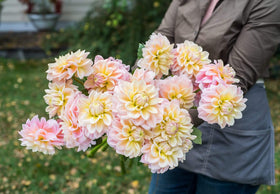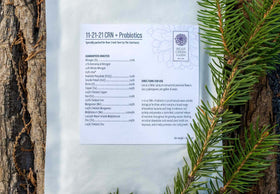For decades, an old rule has been a guide: wait for a hard frost, then wait two more weeks before digging. Like much traditional advice, it’s partly true. Frost does signal an ending, but it’s not what makes a dahlia tuber ready. What matters far more is time—the weeks the plant spends underground after it receives nature’s signal to begin storing energy.
When Tuber Growth Actually Begins
Dahlias form their tubers late in the season, and the trigger is light, not cold. When day length drops below about 12 hours, the plant’s hormones shift: flower production slows, and the plant begins to channel carbohydrates from its leaves down into its roots. That’s when tuber formation truly begins.
From that moment, the tubers need roughly six weeks of active growth in the soil to mature—to accumulate starch, strengthen cell walls, and complete their internal architecture. After shorter days signal the plant to begin storing energy, mild nights in the 50s allow dahlias to keep sending sugars from their leaves down into the tubers, even as flowers continue above ground. As nights cool toward the mid-40s, that movement slows—the plant senses the season’s close and begins preparing for rest. Once temperatures hover near or below 45°F, growth ceases and the two-week period begins, when moisture balances and the outer skins toughen for winter storage.
Under normal circumstances, by the time hard frost appears, the tubers are usually biologically mature—their growth complete, their reserves stored. What comes next is not growth, but conditioning.
Why the Two-Week Wait Matters
The traditional advice to “wait two more weeks after frost” was never about finishing growth—it was about stabilizing moisture. When frost kills the top growth, the plant stops pulling water upward. The moisture inside the tubers now begins to redistribute and slowly leave the surface tissues. Over about 10 to 14 days, those outer cells toughen and dry just enough to form what growers call the winter skin—a thin, corky layer that protects the tuber from dehydration and decay in storage.
Before frost, the plant is growing tubers. After frost, the tubers are curing. If you dig immediately after frost, the skins are still tender and full of water; they’ll tear easily and store poorly. Give them those two weeks in the earth, and they’ll settle into equilibrium—firm, leathery, and resilient.
If You Don’t Get Frost
In many mild or coastal climates, hard frost never arrives. You can still achieve the same physiological pause by ending growth yourself: cut all blooms and buds to stop the plant’s flowering program, withhold water for about two weeks, and let the plants stand in the ground for that same 10–14-day curing period before digging. This mimics what frost does naturally: it stops growth, allowing moisture balance to occur underground.
The True Timeline of a Dahlia Tuber
Photoperiod trigger: Day length drops below 12 hours → the plant begins forming tubers.
Growth phase: About six weeks of underground energy storage → starch accumulation and full maturity.
Curing phase: Two additional weeks after growth stops → moisture redistribution and skin hardening.
So, while the “frost plus two weeks” rule is a tidy shorthand, the real principle is simpler: tubers need six weeks to grow and two weeks to rest. That cycle unfolds within roughly four to five months in the ground—the time it takes for a dahlia to move from sprout to storage readiness. It’s the rhythm of their biology—first creation, then stillness.





Thanks so much! Have a restful summer!
Thanks for the great information! It’s going to be work to care for; but the flower is so stunning!
Best article ever on dahlia care with excellent info on the science behind the care.
Very helpful article!
This is an excellent article! TY